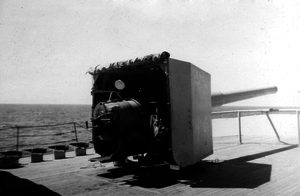BL 6-inch Mk VII naval gun
| BL 6-inch gun Mk VII | |
|---|---|
|
Aboard HMCS Prince David circa 1941 | |
| Type |
Naval gun Coastal defence gun Heavy field gun |
| Place of origin |
|
| Service history | |
| In service |
1901–72 (Fort Scratchley) 1915–18 (field use) |
| Wars | World War II |
| Production history | |
| Designer | Vickers |
| Designed | 1899 |
| Number built | 898 |
| Variants | Mk VII, Mk VIIv, Mk VIII, Mk XXIV |
| Specifications | |
| Weight |
16,875 lb (7,654 kg) (gun & breech)[1] 25 tons (gun on field carriage) |
| Length | 279.228 inches |
| Barrel length | 269.5 in (6.85 m) (44.9 cal) |
| Crew | 9 |
|
| |
| Shell | Lyddite, HE, Shrapnel 100 lb (45 kg)[2] |
| Calibre | 6 in (152 mm) |
| Breech | Welin interrupted screw |
| Recoil | 16.5 in (419 mm) |
| Rate of fire | 8 rpm[3] |
| Muzzle velocity |
2,525 ft/s (770 m/s) (light charge) 2,775 ft/s (846 m/s) (heavy charge)[note 1] |
| Maximum firing range | Field carriage Mk. II : 13,700 yd (12,500 m)[4] Naval : 14,600 yd (13,400 m) (light charge); 15,800 yd (14,400 m) (heavy charge)[5][note 2] |
| Filling weight |
Lyddite : 13 lb 5 oz (6.0 kg) Amatol : 8 lb 14 oz (4.0 kg) Shrapnel : 874 balls @ 27/lb[6] |
The BL 6 inch gun Mark VII (and the related Mk VIII)[note 3] was a British naval gun dating from 1899, which was mounted on a heavy traveling carriage in 1915 for British Army service to become one of the main heavy field guns in the First World War, and also served as one of the main coast defence guns throughout the British Empire until the 1950s.
Background
The gun superseded the QF six-inch gun of the 1890s, a period during which the Royal Navy had evaluated QF technology (i.e. loading propellant charges in brass cartridge cases) for all classes of guns up to six inches to increase rates of fire. BL Mk VII returned to loading charges in silk bags after it was determined that with new single-action breech mechanisms a six-inch BL gun could be loaded, a vent tube inserted and fired as quickly as a QF six inch gun. Cordite charges in silk bags stored for a BL gun were also considered to represent a considerable saving in weight and magazine space compared to the bulky brass QF cartridge cases.[7]
Naval gun
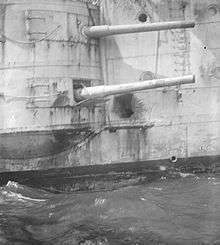
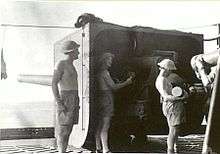
The gun was introduced on the Formidable-class battleships of 1898 (commissioned September 1901) and went on to equip many capital ships, cruisers, monitors, and smaller ships such as the Insect-class gunboat which served throughout World War II.[5]
The Mk VIII in naval service was identical to the Mk VII, except that the breech opened to the left instead of to the right, for use as the left gun in twin turrets.
Guns were mounted in the following ships :
- Formidable-class battleships laid down 1898
- Cressy-class cruisers laid down 1898
- Duncan-class battleships laid down 1899
- Drake-class cruisers laid down 1899
- Monmouth-class cruisers laid down 1899
- Challenger-class cruisers laid down in 1901
- King Edward VII-class battleships HMS Commonwealth, HMS Dominion, HMS Hindustan, HMS King Edward VII, HMS New Zealand laid down 1902
- Devonshire-class cruisers laid down 1902
- HMS Tiger, battlecruiser laid down 1912
- Centurion-class battleships as re-gunned in 1902
- Iron Duke-class battleships laid down 1912
- Humber-class monitors as re-gunned in 1914 with guns from HMS Montagu
- M15-class monitor HMS M27 of 1915
- Insect-class gunboats of 1915
In World War II the gun was used to arm British troop ships and armed merchant cruisers, including HMS Rawalpindi, which briefly fought the German 11-inch gun battlecruisers Scharnhorst and Gneisenau in November 1939, and HMS Jervis Bay which similarly sacrificed herself to save her convoy from the 11-inch pocket battleship Admiral Scheer in November 1940 .
World War I field gun
-
 Media related to BL 6 inch Mk VII field gun at Wikimedia Commons
Media related to BL 6 inch Mk VII field gun at Wikimedia Commons
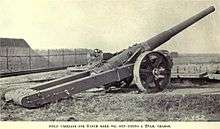
They were first sent to France in 1915 mounted on improvised rectangular-frame field carriages designed by Admiral Percy Scott, based on the design he had improvised for 4.7-inch guns in the Second Boer War, and were successful.[8]
However, elevation and hence range was limited with the Scott carriages so a proper carriage, MK II, was introduced early in 1916, allowing elevation to 22°. Carriages Mks III, V and VI also appeared.
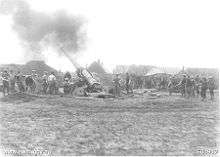

It was operated by the Royal Garrison Artillery, as were all the larger guns, in World War I, in batteries of 4 guns.
Following its successful employment in the Battle of the Somme its role was defined as counter-battery fire and also they "were most effective for neutralising defences and for wire cutting with fuze 106 [a new fuze which reliably burst instantly above ground on even slight contact, instead of forming craters]", also for long-range fire against "targets in depth".[9]
It was superseded by the lighter and longer-range BL 6-inch Gun Mk XIX which was introduced from October 1916 but the Mk VII remained in service to the end of World War I.
Coast defence gun
-
 Media related to BL 6 inch Mk VII coast defence gun at Wikimedia Commons
Media related to BL 6 inch Mk VII coast defence gun at Wikimedia Commons
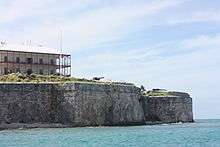



The 6-inch Mk VII gun, together with the 9.2-inch Mk X gun, provided the main coast defence throughout the British Empire, from the early 1900s until the abolition of coast artillery in the 1950s. Many guns were specially built for army coast defence use, and following the decommissioning of many obsolete cruisers and battleships after World War I, their 6-inch Mk VII guns were also recycled for coast defence.
103[10] of these guns were in service in World War I in coastal defences around the UK. Some of these, together with others at ports around the wider British Empire, played an important defence role in World War II and remained in service until the 1950s.
A number of new similar guns with stronger barrels which allowed more powerful cordite charges to be used were manufactured for coast defence during World War II, and were designated 6-inch BL Mark XXIV.[11]
Notable actions
In the German raid on Scarborough, Hartlepool and Whitby on 16 December 1914, a notable action was fought by Durham Company RGA of the Territorial Force at Heugh (2 guns) and Lighthouse (1 gun) batteries defending Hartlepool. They duelled with the German battlecruisers Seydlitz and Moltke (11 inch guns) and Blücher (8.2 inch), firing 112 rounds and scoring 7 hits. The battlecruisers fired a total of 1,150 rounds at the town and the batteries causing 112 civilians and 7 military killed.[12]
World War I Ammunition
 |
 |
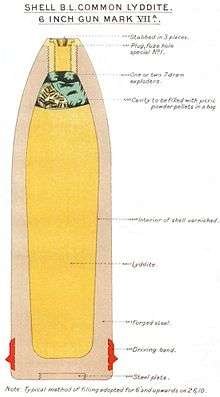 |
 |
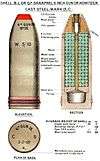 |
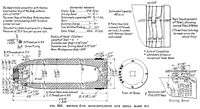 |
See also
Weapons of comparable role, performance and era
- 15 cm L/40 Feldkanone i.R. : German naval gun deployed as field gun in World War I
Surviving examples
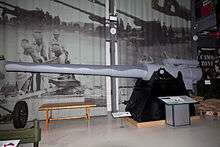
- At the Royal Artillery Museum Woolwich, London.
- A coast defence gun at Newhaven Fort, Sussex, UK
- A gun mounted on the 1904 coast defence emplacement at New Tavern Fort, Gravesend, UK
- 2 coast defence Mk 7 guns at Fort Dunree, Lough Swilly, in County Donegal, Ireland
- St. David's Battery, St. David's Head, St. David's Island, Bermuda. Two Mk VII RBLs, built by Vickers, on Central Pivot Mk II mounts.
- Fort Scratchley, Newcastle, New South Wales, Australia. 2 guns dating from 1911. Decommissioned in 1965 and placed in a nearby park. Moved back to their original mounts in 1978 after the Fort became a museum. Both were restored in 1992 by the Fort Scratchley Historical Society and are capable of being fired on special occasions for ceremonial and saluting purposes.
- Fort St. Catherine's, St. George's Island, Bermuda 6-inch BL Gun Mk VII Gun, built by Vickers, on Central Pivot Mk II mount.
- Warwick Camp, Warwick, Bermuda. Two Mk. VII, built by Vickers, on Central Pivot Mk II mounts. (This is an active military base, and the battery is not accessible by the public. The barrels have reportedly been removed, recently, for remounting on the bastions of the Keep, at the Royal Naval Dockyard, on Ireland Island, which houses the Bermuda Maritime Museum.
- Royal Naval Dockyard, Ireland Island, Bermuda. Two Mk VII (L/1029 and RGF) on Central Pivot Mk II, at Bastions C and D of the Keep (fortress) which houses the Bermuda Maritime Museum (there is also one BL 6-inch Gun Mk II and one BL 6-inch gun Mk IV, at Bastion E).[13][14]
- A gun on field carriage at The Front Museum, Lappohja, Finland
- Fort Ogilvie, Point Pleasant Park, Halifax, Nova Scotia
- VSM gun No. 1553 dated 1901 at Princess Royal Fortress, Albany, Western Australia. Obtained from Bermuda during restoration of the site in the 1980s.
- Barrel 1489 which fired the first Australian shot of WWI, and 1317 which fired the first Australian shot of WWII at Fort Nepean, Victoria
- Mk VII gun dated 1902 at Ile aux Aigrettes, Mauritius
- Momi, Vuda, Batteries, Viti Levu, Fiji Islands. One of the barrels is #1266 from 1900
- Fort Mitchell, Spike Island, Ireland, 2 Mk VII Guns in casemates on Central Pivot Mk II mounts in good condition and in the process of being restored to full working condition.
- Lonehort Fort, Bere Island, County Cork, Ireland- Two 6 inch BL guns are extant- Breech blocks are missing and the guns themselves somewhat rusty, but otherwise appear to be in good condition. The fort was open to the public on 14/03/14 and 15/03/14 for an underground art experience titled "Nest", which took place in the shell rooms below the guns. The shell rooms and hoists are also in good condition.
- Coastal Artillery Battery at Outão, Portugal on the mouth of Sado river, protecting Setubal harbour with 3 guns decommissioned in 1998
Notes
- ↑ 2,525 ft/s firing a 100 lb (45 kg) projectile using 23 lb (10 kg) Cordite MD size-16 propellant; 2,775 ft/s using 28 pounds 10 ounces (13.0 kg) Cordite MD size 26 was the standard naval loading in WWI. Twin mounts and unstrengthened P IV mounts were restricted to the light charge (Treatise on Ammunition 1915). The original loading was 20 lb (9.1 kg) of the more powerful cordite Mk I size 20, but Mk I caused greater wear
- ↑ All figures for 100 lb (45 kg) shell, which was standard in WWI.
- ↑ Mk VII = Mark 7, Mk VIII = Mark 8. Britain used Roman numerals to denote Marks (models) of ordnance until after World War II. Mark VIII's breech opened to the left and Mark VII's opened to the right, allowing for paired mounts. Guns mounted singly were all the right-opening Mark VII
References
- ↑ 7 tons, 10 cwt, 2 qtrs. 19 lbs with breech fitting, including shot guide
- ↑ Shell weights given are filled and fuzed i.e. as fired. 100 lb (45 kg) was standard shell weight in WWI. Some earlier shells had slightly higher weights e.g. Mk IV common lyddite shell weighed 101 lb (45.81 kg)
- ↑ 8 rounds per minute is the figure given by Vickers. Quoted in Brassey's Naval Annual 1901
- ↑ Clarke page 23 quotes 13,700 yd (12,500 m) on the Mk II carriage; General Farndale page 130 quotes 12,000 yd (11,000 m) – this is possibly on the Mk I carriage.
- 1 2 Tony DiGiulian, British 6"/45 (15.2 cm) BL Mark VII
- ↑ Figures for WWI field gun. Hogg & Thurston 1972, Page 243
- ↑ Treatise on Ammunition 10th Edition 1915, page 393
- ↑ Hogg & Thurston 1972, Page 144
- ↑ Farndale 1986 page 158, quoting War Office Artillery Notes No. 4 – Artillery in Offensive Operations, January 1917.
- ↑ Farndale 1988, Page 404
- ↑ DiGiulian
- ↑ Farndale 1988, Pages 368–369, 401.
- ↑ The Bermuda Maritime Museum; Guns and Defences
- ↑ Surviving American Seacoast Artillery Weapons. Compiled: Lists in CDSG News/Journal prepared by C.L. Kimbell (1985), R.D. Zink (1989), and T.C. McGovern (1992 and 1996) (Google document reader)
Bibliography
- Handbook for The 6-Inch Breech Loading Mark XII Gun, 1917. G. 21117/17 (PDF). Admiralty, Gunnery Branch, UK. 1917.
- Dale Clarke, British Artillery 1914–1919. Heavy Artillery. Osprey Publishing, Oxford UK, 2005 ISBN 978-1-84176-788-8
- Tony DiGiulian, British 6"/45 (15.2 cm) BL Mark VII 6"/45 (15.2 cm) BL Mark VIII 6"/45 (15.2 cm) BL Mark XXIV
- General Sir Martin Farndale, History of the Royal Regiment of Artillery. Western Front 1914–18. London: Royal Artillery Institution, 1986. ISBN 978-1-870114-00-4
- General Sir Martin Farndale, History of the Royal Regiment of Artillery. The Forgotten Fronts and the Home Base, 1914–18. London: Royal Artillery Institution, 1988. ISBN 978-1-870114-05-9
- I.V.Hogg & L.F. Thurston, British Artillery Weapons & Ammunition 1914–1918. London: Ian Allan, 1972. ISBN 978-0-7110-0381-1
- Admiral Percy Scott, "Fifty Years in the Royal Navy" published 1919
External links
| Wikimedia Commons has media related to BL 6 inch Mk VII naval gun. |
- Handbook for the 6-inch B. L. guns, marks VII and VIIv, (land service) 1911 at State Library of Victoria
- Terry Gander, Twentieth century British coast defence guns
